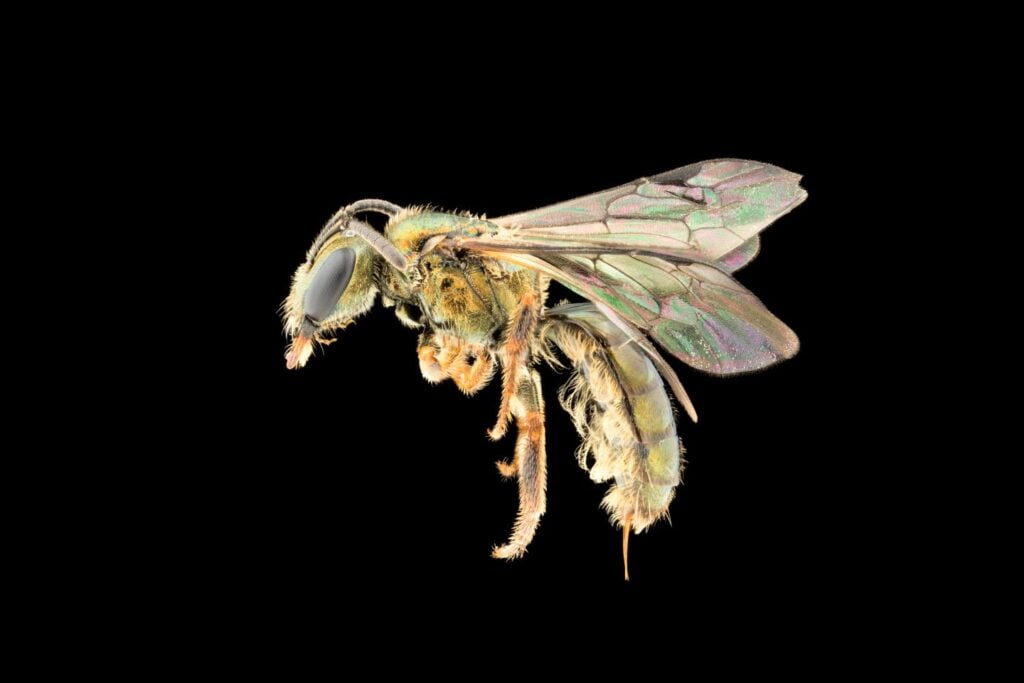- From the island country of Fiji, researchers have described nine new, and four previously known, species of bees belong to the genus Homalictus, a group that’s not been taxonomically reviewed in Fiji for 40 years.
- Many Homalictus bee species either have very restricted distributions or are known only from single mountaintops, the researchers say, and could soon become extinct due to changes in climate and other environmental risks.
- The researchers underscore the need for repeated field surveys to document and describe species from Fiji before they are lost.
- One of the four previously described bee species may have already gone extinct, having not been recorded since 2010, despite extensive surveys in the area.
From the island country of Fiji in southern Pacific Ocean, researchers have described nine new, and four previously known, species of bees, their colors ranging from black to golden-green and metallic, with hints of purple iridescence. All the bees belong to the genus Homalictus Cockerell, a group that’s not been taxonomically reviewed in Fiji for 40 years, the researchers report in a new study.
Many Homalictus bee species either have very restricted distributions or are known only from single mountaintops, the researchers say, and could soon become extinct due to changes in climate and other environmental risks.
One such species is Homalictus terminalis, a new-to-science species of bee that’s only been recorded from Mount Batilamu on the largest island of Viti Levu. On the mountain, the bee seems to be restricted to the top 95 meters (312 feet) of the mountain peak, which lies at an elevation of 1,195 meters (3,921 feet) above sea level. In fact, the researchers named the bee “terminalis” to refer to the limited range of elevation and temperature within which the species occurs.
“Homalictus terminalis is named so to indicate that, like many Fijian bees, it is nearing its limit and is at risk of climate-related extinction,” James Dorey, lead author of the study and a graduate student at Flinders University, Australia, said in a statement.
Another newly described species, H. ostridorsum, has only been documented on Mount Tomanivi, the highest mountain in Fiji on Viti Levu, while H. taveuni is named after the island of Taveuni, the only place it is known from.

Of the four Homalictus species previously described from Fiji, one species, formally known as H. achrostus, may already be extinct.
Researchers had collected six specimens of the bee from Mount Nadarivatu in 1978, followed by two more specimens in 2010. But the bees haven’t been recorded since then, despite extensive surveys in the area, the researchers say.
“A likely driver of this possible extinction is changing climates,” Michael Schwarz, co-author of the study and associate professor at Flinders University, said in the statement. “The cooler climate of the Fijian highlands could be slowly pushed upwards and off the top of the mountains bringing with it the species that require this climatic refuge. With H. achrostus one of the four previously described species of endemic bee in Fiji, this raises real concerns about the extinction of many highland species in Fiji and across all of the tropics.”
Given the restricted distribution of many Homalictus species, and the threats they face, the researchers underscore the need for repeated field surveys.
“These field trips have allowed us to redescribe four known species and describe nine new ones, bringing the number of endemic Homalictus in Fiji to 13 species,” said Mark Stevens, a senior research scientist at the South Australian Museum and a co-author of the paper. “Most of the species diversity (11 species) live 800 metres [2,625 feet] or more above sea level, which highlights the vulnerability of highland-restricted species to a warming climate.”
Citation:
Dorey, J. B., Schwarz, M. P. and Stevens, M. I. (2019) Review of the bee genus Homalictus Cockerell (Hymenoptera: Halictidae) from Fiji with description of nine new species. Zootaxa, 4674(1), 1-46. doi:10.11646/zootaxa.4674.1.1Article
by Mongabay.com on 24 September 2019
